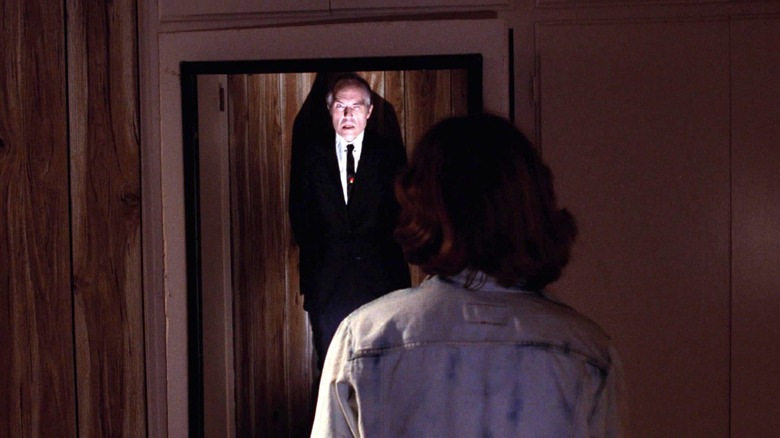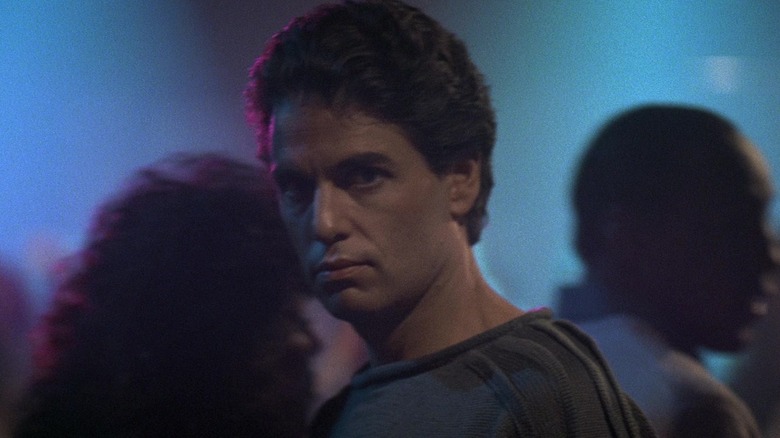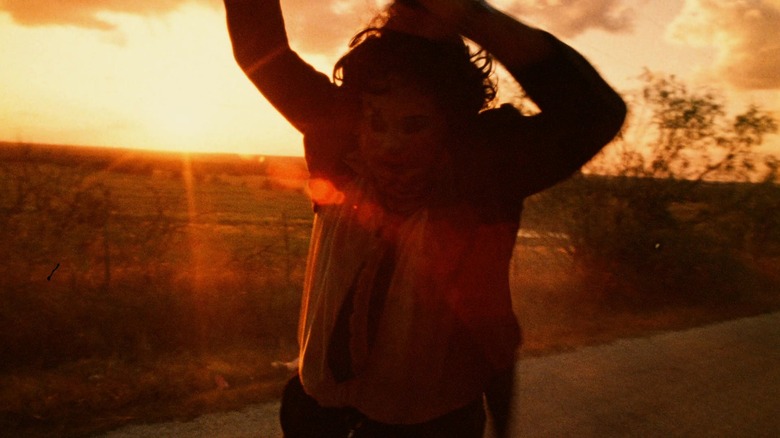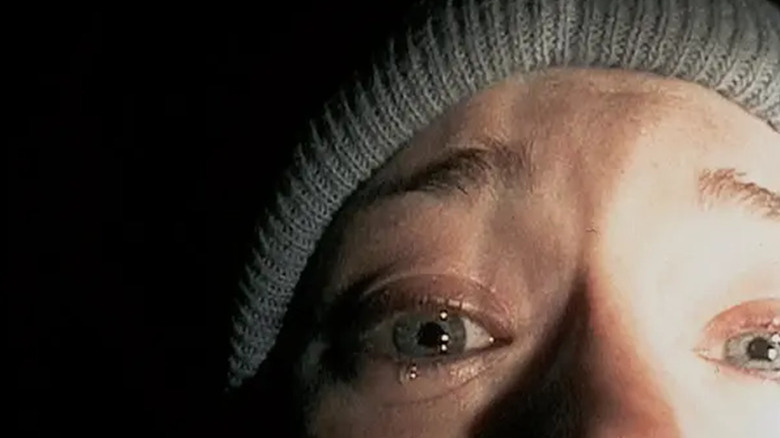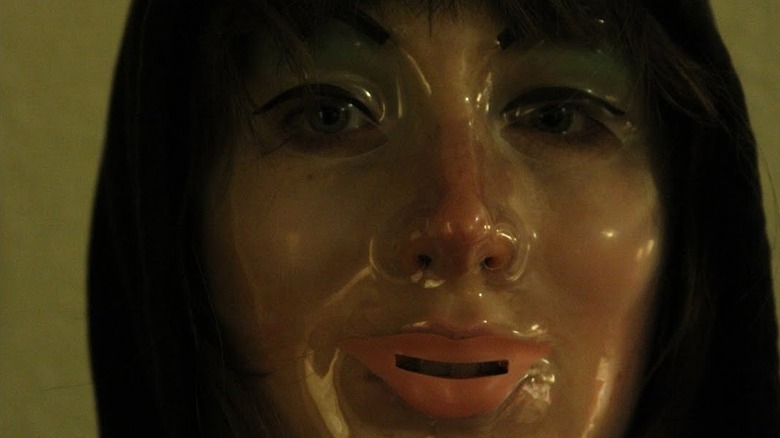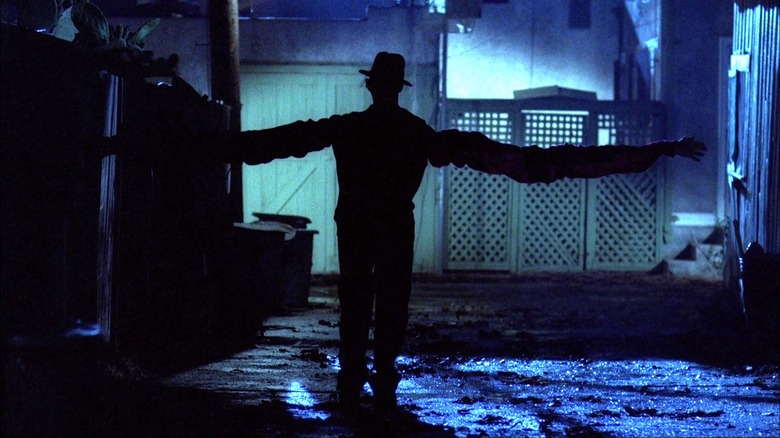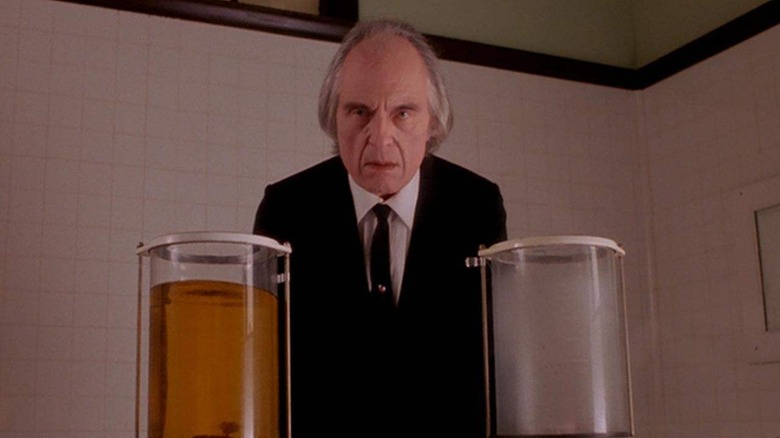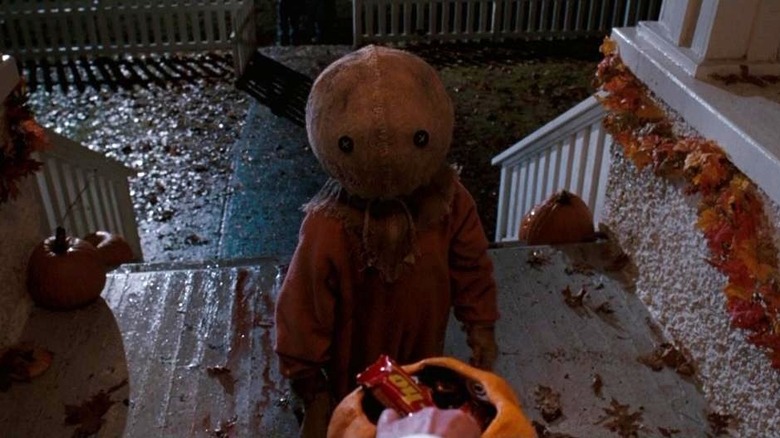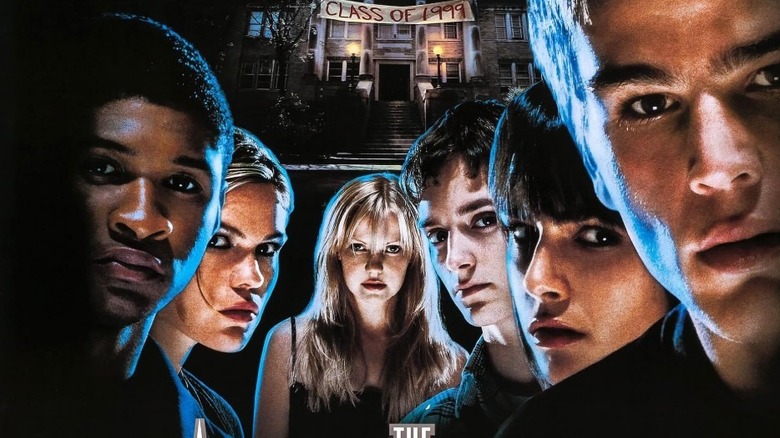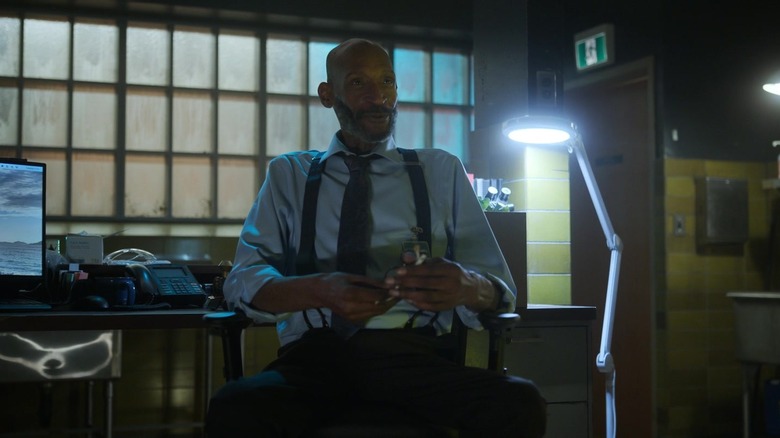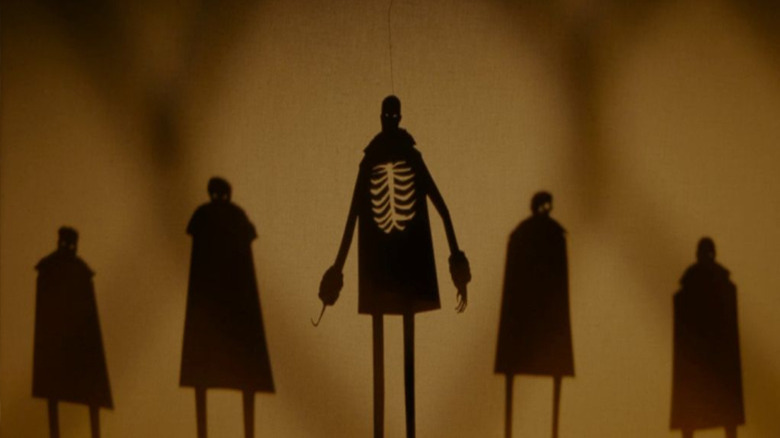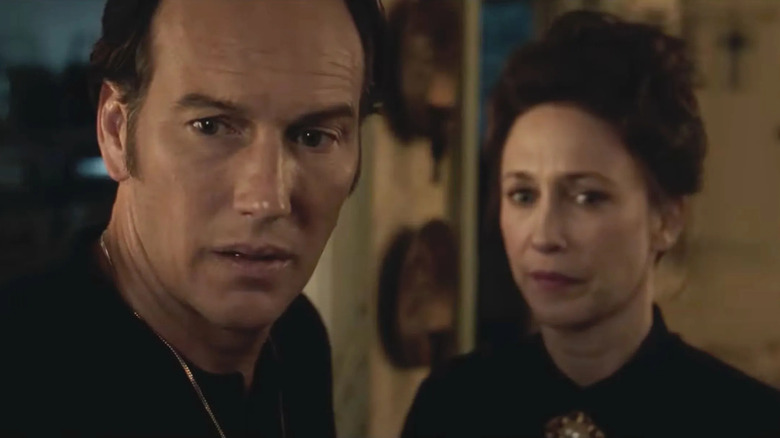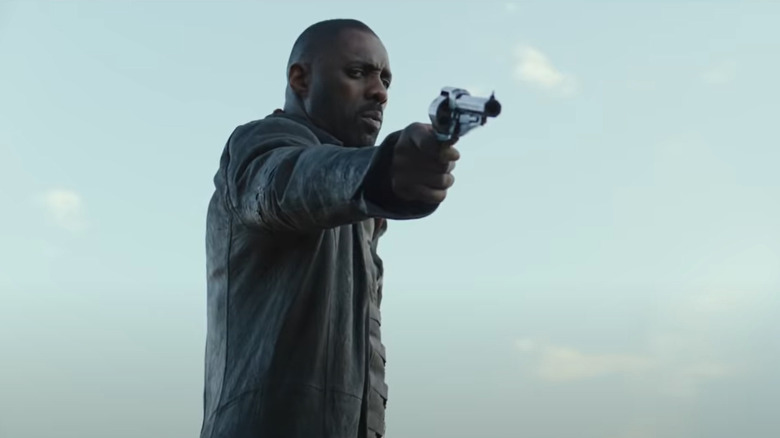Horror Films That Would Make Great TV Shows
Horror is a truly versatile genre that can be applied to a slew of mediums. From the printed page to the big screen — wherever art can be seen, the mad and the macabre can't be too far behind. One medium where horror has definitely flourished is television, with numerous shows spawning multiple sinister seasons.
This includes the ingenious hybrid of horror and science fiction seen on "The Twilight Zone" back in the '60s. In more recent years, we've seen a wave of increasingly gore-heavy shows on primetime television, including "The Walking Dead" and "American Horror Story." One major development includes several horror properties that began on the big screen transitioning over to the small screen. With "Chucky," "Creepshow," and "Ash vs Evil Dead" all becoming quick fan favorites, the door is definitely open for more televised horror. These are just a few notable examples of horror films that lend themselves to episodic adaptations.
Fright Night
"Fright Night" is a film with an absurdly simple premise and an undeniably wonderful, albeit cheesy, execution. Charley Brewster (William Ragsdale), an avid young horror fan, finds his dull suburban life shaken when a new neighbor arrives. Charley soon discovers this bizarre bachelor goes by the name of Jerry Dandrige (Chris Sarandon), and he happens to be a real-life vampire. With Jerry hot on his tail, Charley recruits his favorite horror host, Peter Vincent (Roddy McDowall), to aid him in vanquishing the blood-sucking fiend. The film is chock-full of delightfully antiquated practical effects and an absolutely stellar soundtrack. Featuring J. Geils Band and Devo, the music of "Fright Night" is equal parts sinister and seductive.
Aside from one inevitably inferior sequel and a remake in 2011, the franchise has made very few moves beyond the original film. Given the success of shows like "Teen Wolf" and "Scream," "Fright Night" makes a perfect basis for a series. A multiple-episode format would allow for a more suspenseful buildup and more time to flesh out certain elements, such as Jerry's backstory. And especially considering the recent wave of '80s-oriented nostalgia, setting the series in the Reagan years would be an appropriate tribute to the original.
The Texas Chainsaw Massacre
Several decades after its 1974 release, "The Texas Chainsaw Massacre" is still hailed as a classic. Even after several sequels and various reinterpretations, the franchise remains beloved by hardcore horror fans. Given the divisive reactions towards 2022's "Texas Chainsaw Massacre" released on Netflix, the franchise might just need another facelift. Helpfully, a "Texas Chainsaw" television series could go in a few different directions.
Considering the series' main antagonist's predilection for murdering young people, a format similar to "Scream: The TV Series" would work well. A production company would only need to cast a batch of youthful and likable young stars to contend with the relentless mayhem of Leatherface. A show in this mold would also provide a chance to flesh out the legend of Leatherface to an extent that's not really plausible in a 120-minute film.
Another route they could take is one in tune with the trend of true crime and serial killer-related media. Given the franchise's connection to the real-life story of Ed Gein, the style wouldn't be out of place. A faux-documentary series done in the mold of Netflix's true crime documentaries could make for a disturbing viewing experience.
The Blair Witch Project
In the annals of found footage horror, few names are regarded with a level of praise that matches "The Blair Witch Project." The film is a true testament to DIY filmmaking and what can be accomplished with the absolute barest of minimums. Even today, the film succeeds at creeping out viewers due to its minimalist and extremely grounded presentation. It can also be partially credited for adding fuel to the fire that would eventually become the found footage movie boom.
Given how the found-footage horror subgenre has exploded in the past decade, this would be the perfect time to finally bring the Blair Witch to TV after a proposed series has languished in developmental limbo for years. While found footage is used as narrative device on TV from time to time, there hasn't really been a major found footage television series. The legend of the titular Blair Witch could definitely benefit from the additional time to flesh out its lore. Given the rise of experimental horror on streaming and cable, it would be interesting to see the Blair Witch in a new light.
V/H/S
When you watch one of the "V/H/S" movies, you can never be sure what you're going to be subjected to. Originally spawned through connections cultivated by producer Brad Miska, the first film has been described as a trust-fall exercise between several promising directors (via IndieWire). What spawned from this endeavor was the eclectic found-footage horror anthology known as "V/H/S." The first film, much like its subsequent sequels, consists of several found footage shorts held together by a wraparound segment.
The series contains a swarm of horror tropes and concepts like ghosts, aliens, demons, and human sacrifice. Additionally, the found-footage format allows the viewer to feel like they're along for the ride throughout every vignette. Considering the anthology format, the possibilities for a "V/H/S" series are endless. On paper, the potential of a TV-MA found footage version of "The Twilight Zone" sounds pretty substantial. It would also provide a perfect avenue for fresh young horror directors to cut their teeth.
A Nightmare on Elm Street
While Freddy Krueger is no stranger to television, his first outing wasn't an outright extension of the films. As opposed to a series contingent upon an ongoing narrative or mystery, "Freddy's Nightmares" — which lasted for two seasons airing from 1988 to 1990 — opted for an anthology format. Much like the Crypt Keeper in "Tales from the Crypt," Freddy serves more as a host of the show than as the primary villain, breaking tradition from his usual role in the "Nightmare" movies. While definitely creative, "Freddy's Nightmares" was definitely a product of the 1980s and is undeniably dated in many respects. With that in mind, it might just be time for everyone's favorite striped sweater-wearing psycho to return to television.
The "Nightmare on Elm Street" franchise has mostly laid dormant since Platinum Dunes' unfortunate 2010 remake. Outside of some video game appearances and a cameo on "The Goldbergs," the world of pop culture hasn't seen much of Freddy Krueger in the last 12 years. With that in mind, the story of the Springwood Slasher could make for some truly enthralling and terrifying television. It also helps that Mike Flanagan, the mind behind "The Haunting of Hill House," has been vying to reboot the series for some time. With the franchise's reliance on surreal horror visuals, a multi-episode series would be rife with horrific potential.
Phantasm
In terms of horror franchises, "Phantasm" isn't mentioned as frequently as the likes of "Halloween" and "Friday the 13th." That is most definitely a shame, as the original film is a truly terrifying and often forgotten gem of the 1970s. The film, as well as the subsequent series, was conceived of by Don Coscarelli after watching audiences react to the jump scares in one of his previous films. Coscarelli also pointed to Ray Bradbury's "Something Wicked This Way Comes" and Dario Argento's "Suspiria" as inspirational material for the surreal narrative of "Phantasm." The film, as well as the series, centers on the machinations of the sinister Tall Man, played by Angus Scrimm.
A few main characters show up again in the sequels, but the most frequently recurring is Reggie (Reggie Bannister) — an ice cream man turned action hero. To say the films are insane would be an understatement, and if there's one thing we definitely need more of on scripted television, it's insanity.
Trick 'r Treat
In terms of representing the holiday of Halloween, "Trick 'r Treat" has everything from child murder to seductive werewolves to vengeful child zombies. The film, much like "Creepshow" or "V/H/S," is an anthology containing four separate stories all happening on Halloween night. A curious being named Sam, short for Samhain, is at the center of all the madness. Dressed in an orange onesie with a burlap sack on his head, Sam makes sure everyone follows the rules of Halloween. This, of course, results in brutal, bloody agony for those who dare to break the rules. The film is the brainchild of Michael Dougherty, who since has gone onto helm films for the "Godzilla" franchise. Despite a limited release, "Trick 'r Treat" has gone onto cult status and became a staple of the Halloween season in certain social circles.
Fans have been clamoring for a sequel for years. Sadly, nothing has materialized. Sam himself has appeared elsewhere, such as supplemental short vignettes to promote the erstwhile digital cable network Fearnet. Like other horror films that utilize the anthology format, a "Trick 'r Treat" series showcasing tales of other Halloween nights gone wrong could make for stupendous nightmare fuel.
The Faculty
A star-studded movie with an essentially old-school premise, "The Faculty" is a truly underrated oddity of the late '90s. An Ohio high school — populated with your standard nerds, jocks, goths, and burnouts — just so happens to be selected as ground zero for an alien invasion. One by one, the teaching staff and the students are all taken over by the extraterrestrial threat. The film's premise — part high school drama, part "Invasion of the Body Snatchers" — has some generic elements. But there's nothing generic about its cast, which includes then-current and future Hollywood stars like Elijah Wood, Jon Stewart, Salma Hayek, Robert Patrick, and more.
The film plays almost like an R-rated "Goosebumps" episode, right down to the cheesy special effects and occasionally hokey dialogue. Directed by Robert Rodriguez, the film succeeds as an effective and energetic alien invasion story. Given the seemingly never-ending need for high school-centered shows, "The Faculty" makes an obvious candidate for a relaunch or reboot on TV.
Final Destination
The "Final Destination" movies have gotten a lot of mileage from its phenomenally simple yet effective premise. Essentially, all the stories in "Final Destination" movies revolve around a group of people who, usually through some unexplained clairvoyance, unknowingly cheat their way out of their originally planned deaths. Often, this original demise is a large, big-budget set piece such as a fiery airline crash or a multi-car highway accident. Death — the literal, invisible omnipresence of Death — sets about picking off their escaped would-be victims in their initially planned order.
Because Death apparently has a twisted sense of humor, the "Final Destination" films are loaded increasingly absurd and gruesome Rube Goldberg-style deaths. Characters get killed by buses, factory equipment, home appliances, tanning beds, car safety features, barbed wire fences, and even Lasik eye surgery disasters. With television growing more open and agreeable to displays of grotesque and ridiculous violence, especially on streaming, it might just be time to adapt "Final Destination" for the small screen.
Candyman
With the critical success of Nia DaCosta's "Candyman," the door appears very much open for another look at everyone's favorite hook-handed friend of the bees. The legend of the Candyman was conceived of by horror scribe Clive Barker in a short story from the mid-'80s. That short story — "The Forbidden" — inspired a 1992 film adaptation starring Virginia Madsen and the incomparable Tony Todd in the title role. The film outlines the tragic origin of the Candyman, who was once an innocent Black painter brutalized and killed by the violent bigots of his time. The aforementioned 2021 follow-up, directed by DaCosta, expands on this idea by suggesting that Candyman isn't just one man, but a spirit of vengeance for Black people who've been wronged in various ways.
The 2021 film ends with Candyman informing a surviving primary character to "tell everyone." The credits display a stylized shadow puppet show that outlines the various Candymen and their trails of retribution. A show going into more detail about tales of the Candyman throughout history would be truly fascinating.
The Conjuring
Very few recent horror movies have scared up the positive critical response and immense box office of "The Conjuring." The four proper "Conjuring" films focus on Ed and Lorraine Warren — a husband and wife paranormal investigation duo. Based on dubiously real events, each film centers on the Warrens tackling a different supernatural threat or demonic entity. The success of the first two films spawned several spinoffs – including the "Annabelle" trilogy and "The Nun" series.
The "Conjuring" movies ended strong at the box office, with the final film of the franchise, "The Conjuring: Last Rites," earning nearly $500 million in 2025. And while it's the last time we'll see Patrick Wilson and Vera Farmiga, it did inspire Warner Bros. to order up a sequel. The studio is also now working on a "Conjuring" TV show, with Nancy Won of "Jessica Jones" and "Little Fires Everywhere" serving as showrunner.
At this point, we're unsure what the TV show will be about, but given the episodic nature of the Warrens' paranormal escapades, television feels like the perfect fit for the "Conjuring" world. In fact, the Warrens have a room full of cursed items — a television show could easily focus on one haunted object per episode, giving the backstory to how these demonic items ended up in the Warrens' museum.
The Dark Tower
"The Dark Tower" book series has been hailed as writer Stephen King's literary magnum opus. The series centers on Roland the Gunslinger and his ongoing search for the eponymous Dark Tower amidst a post-apocalyptic wasteland rife with peril. One of these perils includes his greatest enemy, the Man in Black — a demonic figure with necromancy abilities. Whereas most Stephen King novels tend to pick a singular genre to reside in, that's not the case with "The Dark Tower." In "The Dark Tower," horror is on the menu, along with fantasy, science fiction, and even elements of old-school Westerns.
Another interesting aspect of the series is how it connects all of King's other works together in strangely fitting ways. Through name drops of various characters and locations, there are connections back to "It," "The Shining," and "The Stand." A "Dark Tower" film came out in 2017, but it serves as more of a sequel to the novels than a direct adaptation. While a televised version of the saga was partially developed by Glen Mazzara of "The Walking Dead," Amazon officially passed on moving ahead with that "Dark Tower" series in 2020. At the moment, Mike Flanagan of "Midnight Mass" fame is attached to a potential adaptation, although we haven't heard any significant update on this series as of yet. Hopefully, Flanagan will finally be able to summon his ka-tet of usual collaborators and lead us across the desert to the long-fabled tower.
